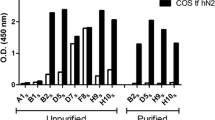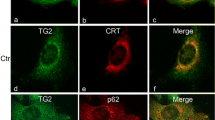Abstract
Gamma-glutamyl transferase (GGT5) was discovered due to its ability to convert leukotriene C4 (LTC4, a glutathione S-conjugate) to LTD4 and may have an important role in the immune system. However, it was not known which cells express the enzyme in humans. We have developed a sensitive and specific antibody that can be used to detect human GGT5 on Western blots and in fixed tissue sections. We localized GGT5 expression in normal human tissues. We observed GGT5 expressed by macrophages present in many tissues, including tissue-fixed macrophages such as Kupffer cells in the liver and dust cells in the lung. GGT5 was expressed in some of the same tissues that have been shown to express gamma-glutamyl transferase (GGT1), the only other enzymatically active protein in this family. But, the two enzymes were often expressed by different cell types within the tissue. For example, GGT5 was expressed by the interstitial cells of the kidney, whereas GGT1 is expressed on the apical surface of the renal proximal tubules. Other tissues with GGT5-positive cells included: adrenal gland, salivary gland, pituitary, thymus, spleen, liver, bone marrow, small intestine, stomach, testis, prostate and placenta. GGT5 and GGT1 are cell surface enzymes. The different pattern of expression results in their access to different extracellular fluids and therefore different substrates. GGT5 has access to substrates in blood and intercellular fluids, while GGT1 has access primarily to fluids in ducts and glands throughout the body. These data provide new insights into the different functions of these two related enzymes.





Similar content being viewed by others
References
Bello MH, Epstein L (2013) Clades of gamma-glutamyltransferases (GGTs) in the ascomycota and heterologous expression of Colletotrichum graminicola CgGGT1, a member of the pezizomycotina-only GGT clade. J Microbiol 51(1):88–99. doi:10.1007/s12275-013-2434-0
Carcangia ML (2007) Thyroid. In: Mills SE (ed) Histology for pathologists, 3rd edn. Lippincott Williams and Wilkins, Philadelphia, pp 1130–1148
Carter BZ, Wiseman AL, Orkiszewski R, Ballard KD, Ou CN, Lieberman MW (1997) Metabolism of leukotriene C4 in gamma-glutamyl transpeptidase-deficient mice. J Biol Chem 272(19):12305–12310
Carter BZ, Shi ZZ, Barrios R, Lieberman MW (1998) gamma-glutamyl leukotrienase, a gamma-glutamyl transpeptidase gene family member, is expressed primarily in spleen. J Biol Chem 273(43):28277–28285
DeBault LE, Cancilla PA (1980) gamma-Glutamyl transpeptidase in isolated brain endothelial cells: induction by glial cells in vitro. Science 207(4431):653–655
Han B, Luo G, Shi ZZ, Barrios R, Atwood D, Liu W, Habib GM, Sifers RN, Corry DB, Lieberman MW (2002) Gamma-glutamyl leukotrienase, a novel endothelial membrane protein, is specifically responsible for leukotriene D(4) formation in vivo. Am J Pathol 161(2):481–490
Hanigan MH, Frierson HF Jr (1996) Immunohistochemical detection of gamma-glutamyl transpeptidase in normal human tissue. J Histochem Cytochem 44(10):1101–1108
Hanigan MH, Ricketts WA (1993) Extracellular glutathione is a source of cysteine for cells that express gamma-glutamyl transpeptidase. Biochemistry 32(24):6302–6306
Heisterkamp N, Rajpert-De Meyts E, Uribe L, Forman HJ, Groffen J (1991) Identification of a human gamma-glutamyl cleaving enzyme related to, but distinct from, gamma-glutamyl transpeptidase. Proc Natl Acad Sci USA 88(14):6303–6307
Heisterkamp N, Groffen J, Warburton D, Sneddon TP (2008) The human gamma-glutamyltransferase gene family. Hum Genet 123(4):321–332. doi:10.1007/s00439-008-0487-7
Kaissling B, Le Hir M (2008) The renal cortical interstitium: morphological and functional aspects. Histochem Cell Biol 130(2):247–262. doi:10.1007/s00418-008-0452-5
King JB, West MB, Cook PF, Hanigan MH (2009) A novel, species-specific class of uncompetitive inhibitors of gamma-glutamyl transpeptidase. J Biol Chem 284(14):9059–9065. doi:10.1074/jbc.M809608200
Law SH, Redelings BD, Kullman SW (2012) Comparative genomics of duplicate gamma-glutamyl transferase genes in teleosts: medaka (Oryzias latipes), stickleback (Gasterosteus aculeatus), green spotted pufferfish (Tetraodon nigroviridis), fugu (Takifugu rubripes), and zebrafish (Danio rerio). J Exp Zool B Mol Dev Evol 318(1):35–49. doi:10.1002/jez.b.21439
Lieberman MW, Wiseman AL, Shi ZZ, Carter BZ, Barrios R, Ou CN, Chevez-Barrios P, Wang Y, Habib GM, Goodman JC, Huang SL, Lebovita RM, Matzuk MM (1996) Growth retardation and cysteine deficiency in gamma-glutamyl transpeptidase-deficient mice. Proc Natl Acad Sci USA 93(15):7923–7926
Martinez FO, Gordon S, Locati M, Mantovani A (2006) Transcriptional profiling of the human monocyte-to-macrophage differentiation and polarization: new molecules and patterns of gene expression. J Immunol 177(10):7303–7311
Okada T, Suzuki H, Wada K, Kumagai H, Fukuyama K (2006) Crystal structures of gamma-glutamyltranspeptidase from Escherichia coli, a key enzyme in glutathione metabolism, and its reaction intermediate. Proc Natl Acad Sci USA 103(17):6471–6476
Potdar PD, Andrews KL, Nettesheim P, Ostrowski LE (1997) Expression and regulation of gamma-glutamyl transpeptidase-related enzyme in tracheal cells. Am J Physiol 273(5 Pt 1):L1082–L1089
Shi ZZ, Han B, Habib GM, Matzuk MM, Lieberman MW (2001) Disruption of gamma-glutamyl leukotrienase results in disruption of leukotriene D(4) synthesis in vivo and attenuation of the acute inflammatory response. Mol Cell Biol 21(16):5389–5395. doi:10.1128/MCB.21.16.5389-5395.2001
Tsuji T, Mimori Y, Nakamura S, Kameyama M (1987) A micromethod for the isolation of large and small microvessels from frozen autopsied human brain. J Neurochem 49(6):1796–1800
West MB, Segu ZM, Feasley CL, Kang P, Klouckova I, Li C, Novotny MV, West CM, Mechref Y, Hanigan MH (2010) Analysis of site-specific glycosylation of renal and hepatic gamma-glutamyl transpeptidase from normal human tissue. J Biol Chem 285(38):29511–29524. doi:10.1074/jbc.M110.145938
West MB, Chen Y, Wickham S, Heroux A, Cahill K, Hanigan MH, Mooers BH (2013) Novel insights into eukaryotic gamma-glutamyl transpeptidase 1 from the crystal structure of the glutamate-bound human enzyme. J Biol Chem 288(44):31902–31913. doi:10.1074/jbc.M113.498139
Wickham S, West MB, Cook PF, Hanigan MH (2011) Gamma-glutamyl compounds: substrate specificity of gamma-glutamyl transpeptidase enzymes. Anal Biochem 414:208–214. doi:10.1016/j.ab.2011.03.026
Acknowledgments
We would like to thank the National Disease Research Interchange (NDRI, Philadelphia, PA) for procurement of the kidney samples used in this study and Ms. Jeanne Frazier, Medical Technologist, OU Anatomic Pathology Laboratory for immunolabeling of the tissues. Research reported in this publication was supported by The Oklahoma Center for the Advancement of Science and Technology (OCAST) grant number HR11-085 (M.H.H.) and by an Institutional Development Award (IDeA) from the National Institute of General Medical Sciences of the National Institutes of Health under grant number P20GM103640.
Conflict of interest
None.
Statement of human rights
This manuscript does not contain clinical studies or patient data.
Author information
Authors and Affiliations
Corresponding author
Rights and permissions
About this article
Cite this article
Hanigan, M.H., Gillies, E.M., Wickham, S. et al. Immunolabeling of gamma-glutamyl transferase 5 in normal human tissues reveals that expression and localization differ from gamma-glutamyl transferase 1. Histochem Cell Biol 143, 505–515 (2015). https://doi.org/10.1007/s00418-014-1295-x
Accepted:
Published:
Issue Date:
DOI: https://doi.org/10.1007/s00418-014-1295-x




